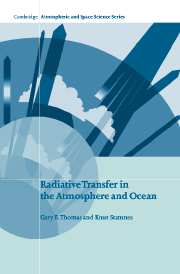Book contents
- Frontmatter
- Contents
- List of Illustrations
- Preface
- Acknowledgments
- Chapter 1 Basic Properties of Radiation, Atmospheres, and Oceans
- Chapter 2 Basic State Variables and the Radiative Transfer Equation
- Chapter 3 Basic Scattering Processes
- Chapter 4 Absorption by Solid, Aqueous, and Gaseous Media
- Chapter 5 Principles of Radiative Transfer
- Chapter 6 Formulation of Radiative Transfer Problems
- Chapter 7 Approximate Solutions of Prototype Problems
- Chapter 8 Accurate Numerical Solutions of Prototype Problems
- Chapter 9 Shortwave Radiative Transfer
- Chapter 10 Transmission in Spectrally Complex Media
- Chapter 11 Radiative Transfer in Nongray Media
- Chapter 12 The Role of Radiation in Climate
- Appendices
- A Nomenclature: Glossary of Symbols
- B Physical Constants
- C Model Atmospheres
- D Ocean Optics Nomenclature
- E Reflectance and Transmittance at an Interface
- Index
C - Model Atmospheres
Published online by Cambridge University Press: 18 December 2009
- Frontmatter
- Contents
- List of Illustrations
- Preface
- Acknowledgments
- Chapter 1 Basic Properties of Radiation, Atmospheres, and Oceans
- Chapter 2 Basic State Variables and the Radiative Transfer Equation
- Chapter 3 Basic Scattering Processes
- Chapter 4 Absorption by Solid, Aqueous, and Gaseous Media
- Chapter 5 Principles of Radiative Transfer
- Chapter 6 Formulation of Radiative Transfer Problems
- Chapter 7 Approximate Solutions of Prototype Problems
- Chapter 8 Accurate Numerical Solutions of Prototype Problems
- Chapter 9 Shortwave Radiative Transfer
- Chapter 10 Transmission in Spectrally Complex Media
- Chapter 11 Radiative Transfer in Nongray Media
- Chapter 12 The Role of Radiation in Climate
- Appendices
- A Nomenclature: Glossary of Symbols
- B Physical Constants
- C Model Atmospheres
- D Ocean Optics Nomenclature
- E Reflectance and Transmittance at an Interface
- Index
Summary
Reference atmospheric models have long been used for a variety of purposes: validation of theoretical atmospheric models, intercomparison of radiation codes, and design and mission planning for aerospace systems, to mention a few applications. Standard atmospheres typically provide numerical values for the thermodynamic variables (pressure, temperature, density, etc.) and concentrations of minor species.
Atmospheric models may be considered to be the result of an ingestion of the best data sets available at the time; consequently, the older models (such as the 1976 U. S. Standard Atmosphere) do not represent the current state-of-the-art knowledge. For our purposes they are most useful for comparing the output of radiation codes.
In Tables C.1 to C.6 we present six model atmospheres, which contain, among other variables, the temperature and constituent concentrations for H2O, CO2, O3, and NO2. With the exception of CH4 (not listed) these five species are the most important infrared-active gases in Earth's atmosphere. It should be mentioned that the tabulated values of H2O and NO2 in the upper stratosphere and mesosphere are not to be trusted as representative of the Earth's upper regions, since these models were created more than twenty-five years ago. Modern remote sensing measurements of these constituents provide much more accurate values of H2O, O3, and NO2, as well as other species, such as NO and O.
- Type
- Chapter
- Information
- Radiative Transfer in the Atmosphere and Ocean , pp. 490 - 502Publisher: Cambridge University PressPrint publication year: 1999



